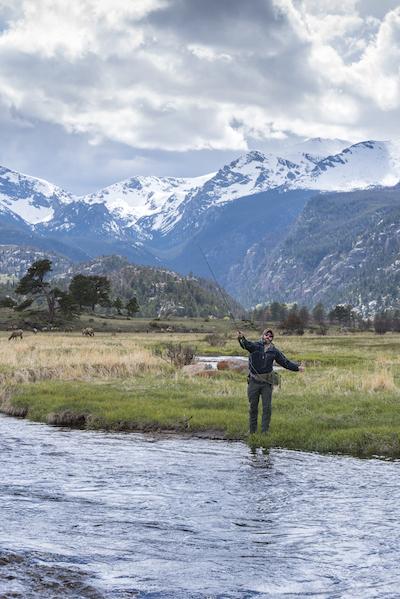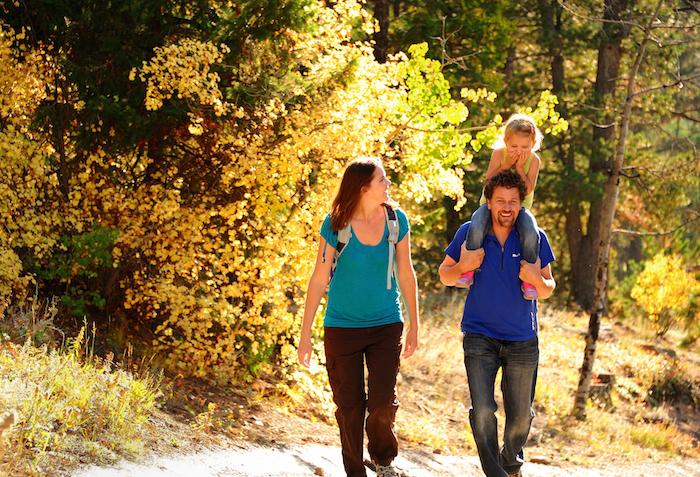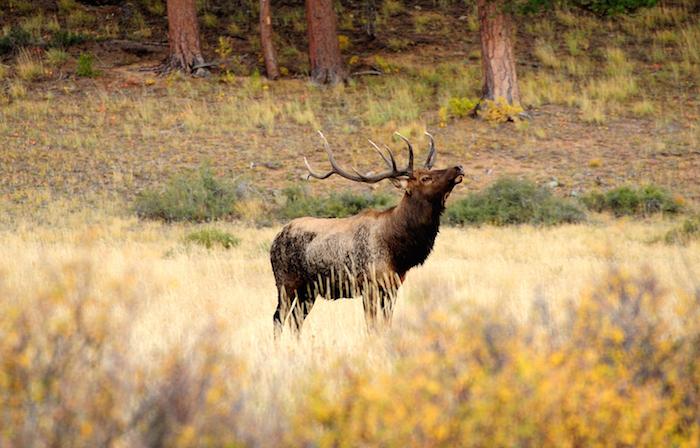
Fall is a great time to mix fly fishing with wildlife watching in Rocky Mountain National Park/James Frank
Editor's note: This is a special advertiser-supported article from the Essential Park Guide, Fall 2015.
From enjoying the park’s waters, to relishing the changing scenery and observing the raucous wildlife, autumn in Rocky Mountain National Park is full of adventures and sights you won’t want to miss.
You might call them “relics” or perhaps “throwbacks,” but the Greenback cutthroat trout that have sanctuary in Rocky Mountain National Park could rightly be viewed as an angler’s dream fish.
Thought to be extinct back in the 1930s, the species was rediscovered in 1957 inside the park. Today the Greenback is still considered a threatened species by both Colorado and the federal government, and so you must release any you catch back into the stream.
While the purity of this population’s DNA have recently been in question, the beauty and prestige of the park’s Greenback cutthroat can’t be denied, and local anglers will tell you that the possibility of landing one, if only for a minute or so, is an honor. One that ties you to a species that for 20,000 years has been at home in these waters.
Fishing the park’s waters, which also are home to brown, brook, and rainbow trout that you can take home for dinner, is one of the most sublime ways of experiencing Rocky Mountain National Park. It’s not the only way, though, as there are more than 60 peaks in the park that rise above 12,000 feet, and the spectacular alpine scenery draws visitors from around the world.
The cliffs, lakes, meadows, canyons and rivers have been carved into an exquisite wilderness. With over a quarter of a million acres, it’s a great place to find tranquility and adventure.
Leave Your Car Behind
To really experience the mountains, get away from the roads and go boating, horseback riding, fishing, hiking, cycling or climbing. Your escape might be as simple as spending an hour at an overlook, watching the wildlife in a meadow move around.
Taking just a few minutes to step away from your car can open up a whole new world. Just make sure you’re carrying a raincoat, sunscreen and water; the weather changes quickly in the mountains.
Rocky Mountain is a hiker’s paradise, with more than 350 miles of trails, from easy ambles to tough scrambles. One of the best hikes has to be the trail up 12,880-foot Mount Ida; the top is a bit of a scramble, but there’s little exposure and the view is phenomenal. You could also head down the Ute Trail, an easy hike along Tombstone Ridge, or take the more challenging 8.4-mile-roundtrip hike to Chasm Lake, with its outstanding views of The Diamond, the east face of Longs Peak.

With so many miles to choose from, you can find your own fall paradise in Rocky Mountain National Park/VisitEstesPark
The short Tundra Communities Trail, which begins at the highest point on Trail Ridge Road (over 12,000 feet), provides an incredible alpine experience and spectacular 360-degree sunset views. You’ll be glad you got to stretch your legs, and you will be rewarded. Take note that the park’s altitude can affect your performance, so take it easy and keep hydrated. There are a number of kid-friendly and accessible trails, so ask at one of the park’s visitor centers for directions and pick up Junior Ranger booklets for some extra fun.
Of course, for the more adventurous there are plenty of climbs—easy and epic—to test your mountaineering skills. Longs Peak is the iconic grand lady of the park at 14,259 feet. It stands as a sentinel and is easily seen from many areas, even downtown Estes Park.
If you feel secure with you footing, and you’re in decent shape, try the classic, 15-mile round-trip Keyhole Route up the peak. Thousands of visitors every year clamber up the rocky, exposed rock ledges on the way to the summit, and fast-moving storms increase the challenge. It’s much more than a hike—it’s a climb, and once at the top, you’re only halfway—there’s still the descent. If you’re looking for less of an endeavor, there are many easier and moderate climbs in the park.
Pedaling, Paddling and Angling
If wheels are your deal, get your road bike out and pedal along the park’s roadways. Pay attention to any closures or construction areas, and these mountain roads often have narrow shoulders, so watch for traffic. Early morning and evening rides encounter fewer vehicles and offer the most scenic views, with perfect lighting on the peaks. In the end, your legs and lungs will get a good workout, and your spirit will be renewed.
If you’re in search of the wily trout, these mountain streams will test your mettle and techniques. Head to the highcountry for catch-and-release, or take a boat out on the bigger lakes.
Where else can you cast a fly while elk wander nearby, while autumn leaves burst with color all around? Moraine Park is an ideal spot for this, or a bit west along the Big Thompson River between the Fern Lake and Cub trailheads.
If you seek the Greenback, you might be able to find them in Fern Lake, Dream Lake, or the Roaring River. And in fall, the fish are hungry, preparing for winter.
Speaking of the park’s waters, canoes, paddle boards and kayaks are permitted on all park lakes, with the exception of Bear Lake, and as you paddle quietly, you may see wildlife on these lakes.

Elk, bugling bull elk, specifically, are the main attraction at Rocky Mountain National Park in fall/Darcy Kiefel
You might also opt to take a day to ride horseback through the high country. The Glacier Creek Stables and Moraine Park Stables can set you up for a trail ride, where you’ll cover a lot of country by saddle.
With a backcountry permit, you can head beyond road’s end with your house on your back, and really get away without leaving trace of your presence. Backpacking the wilderness is a way to truly seek the serenity of the wild. The trout aren’t the only wildlife visible in the fall. Head to Horseshoe Park or Moraine Park to watch the bull elk as they bugle their haunting whistles in search of mates. Elk tours and even a festival—the first weekend in October— are offered in Estes Park and teach you more about this annual phenomenon.
In the park, you might also spy some of the park’s bighorn sheep. Overhead, eagles and hawks soar the ridgeline thermals, and coyotes howl under the midnight skies.
There are so many things to do this fall in Rocky Mountain Park, especially if you make an effort to get away from the road and revel in the alpine scenery first-hand, surrounded by the natural world.
After a long day with one of these activities, rest, refuel and re-energize in Estes Park. This base camp for Rocky Mountain National Park offers a variety of spots to relive the day’s feats and regroup for another day in the wild. For more ideas on what to do in the park and nearby Estes Park, and for lodging and dining options, be sure to visit VisitEstesPark.com.



Comments
It seems like it would be helpful for articles like this to actually tell where the park is (other than "Rocky Mountains"). A quick word on where the park's main entrance is or how to get there would be of great benefit to those who don't already know where the park is.
GTS
Re directions to the park, duly noted.
While we did mention "Colorado," it could have been more prominent. Main gateway towns are Estes Park, Colorado, on the eastern side, and Grand Lake, Colorado, on the west.